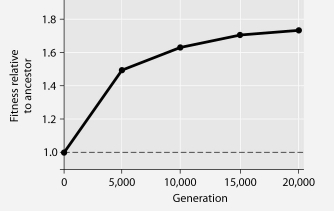Multiple Choice
The following questions refer to Figure 27.1.
In this eight-year experiment, 12 populations of E. coli, each begun from a single cell, were grown in low-glucose conditions for 20,000 generations. Each culture was introduced to fresh growth medium every 24 hours. Occasionally, samples were removed from the populations, and their fitness in low-glucose conditions was tested against that of members sampled from the ancestral (common ancestor) E. coli population.

Figure 27.1
-Which of the following, if it occurs in the absence of any other type of adaptation listed here, is least reasonable in terms of promoting bacterial survival over evolutionary time in a low-glucose environment?
A) increased efficiency at transporting glucose into the cell from the environment
B) increased ability to survive on simple sugars, other than glucose
C) increased ability to synthesize glucose from amino acid precursors
D) increased reliance on glycolytic enzymes
E) increased sensitivity to, and ability to move toward, whatever glucose is present in its habitat
Correct Answer:

Verified
Correct Answer:
Verified
Q11: The data were collected from the heterocysts
Q12: Chloramphenicol is an antibiotic that targets prokaryotic
Q13: In Fred Griffith's experiments, harmless R strain
Q14: If archaeans are more closely related to
Q15: Use the information in the following paragraph
Q17: The following table depicts characteristics of five
Q18: The thermoacidophile, Sulfolobus acidocaldarius, lacks peptidoglycan, but
Q19: Which statement about the domain Archaea is
Q20: In a hypothetical situation, a bacterium lives
Q21: Which of the following is an important